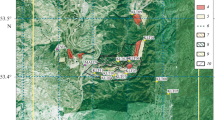Abstract
The Lihir open pit mine in Papua New Guinea is located inside an old volcano where geothermal activity is strongly present. Outbursts of hot water and steam into the mining areas were a major safety concern. Passive seismic monitoring was carried out at the mine to investigate whether the geothermal activities could be detected and located using microseismic techniques in a mining environment. In this trial, sixteen triaxial geophones which can withstand temperature up to 200°C were used and installed in four deep boreholes inside the pit. The microseismic events were discriminated using the STA/LTA triggering criterion. During 6 weeks of monitoring, more than 17,000 events were recorded. Approximately 12% of the events showed harmonic vibration characteristics similar to those observed in other geothermal and volcanic areas, suggesting that the geothermal activity inside the pit was captured by the microseismic monitoring system. More than 75% of the events present both P and S waves and they were interpreted to be associated with rock fracturing due to stress release near the bottom of the pit. Many geothermal-type events were located in areas where shear events occurred, implying that the detected geothermal events were not far from the mining area below the pit and they may also be associated with mining. The borehole installation of the geophones significantly reduced the interference of mining noise and achieved good observation of the seismic events. However, equipment installation requires great attention as the geophones may be destroyed due to unexpected rising temperature within the boreholes.










Similar content being viewed by others
References
Allen R. (1978), Automatic earthquake recognition and timing form single traces, Bull. Seismol. Soc. Am. 68, 1521–1532.
Aki, K., Fehler, M., and Das, S. (1977), Source mechanism of volcanic tremor: Fluid driven crack models and their application to the 1963 Kilauea eruption, J. Volcanol. Geotherm. Res. 2, 259–287.
Bryan, C.J. and Sherburn, S. (1999), Seismicity associated with the 1995-1996 eruption of Ruapehu volcano, New Zealand: Narrative and insights into physical processes, J. Volcanol. Geotherm. Res. 90, 1–18.
Chouet, B. (1988), Excitation of a fluid-driven crack: Radiation properties and implication for the source of long-period events and harmonic tremor, J. Geophys. Res. 93, 4375–4400.
Chouet, B. (1996), Long-period volcano seismicity: Its source and its use in eruption forecasting, Nature 380, 309–316.
Chouet, B. (2003), Volcano seismology, Pure Appl. Geophys. 160, 739–788.
Feng, Q. and Lees, J. M. (1998), Microseismicity, stress, and fracture in the Coso geothermal field, California, Tectonophysics 289, I 1–3, 221–238.
Julian, B.R. (1994), Volcanic tremor: Nonlinear excitation by fluid flow, J. Geophys. Res. 99, 11859–11877.
Luo, X., Ross, J., Hatherly, P., Shen, B., and Duncan Fama, M. (2001), Microseismic monitoring of highwall mining stability at Moura Mine, Australia, Exploration Geophys. 32, 075–079.
Luo, X. (2004), The application of microseismics to assist risk management of mining in geothermal areas at Lihir Gold Mine, PNG—Field trial, CSIRO Project Report 1125R.
McNutt, S.R. (1994), Volcanic tremor from around the world: 1992 update, Acta Volcanologica 5, 197–200.
McNutt, S.R. (1996), Seismic monitoring and eruption forecasting of volcanoes: A review of the state-of-the-art and case histories. In: Monitoring and Mitigation of Volcano Hazards (Eds. R. Scarpa and R.I. Tilling). pp. 100–146.
Seidl, D., Schick, R., and Riuscetti, M. (1981), Volcanic tremors at Etna: A model for hydraulic origin, Bull. Volcanol. 44, 43–56.
Tolstoy, M., Vernon, F.L., Orcutt, J.A., and Wyatt, F.K. (2002), Breathing of the seafloor: Tidal correlations of seismicity at Axial volcano, Geology 30(6), 503–506.
White, S.P., Creighton, A.L, Bixley, P.F., and Kissling, W.M. (2003), Modelling the dewatering and depressurisation of the Lihir open pit gold mine, In Proc. TOUGH Symposium 2003, California, USA, 8 pages.
Acknowledgments
This project was fully supported by Lihir Gold Limited. Thanks are extended to staff members of Lihir Mine who assisted with the borehole drilling, field installation, calibration shot firing and generator maintenance. Two reviewers of the paper are thanked for their valuable comments which enhanced this manuscript.
Author information
Authors and Affiliations
Corresponding author
Rights and permissions
About this article
Cite this article
Luo, X., Creighton, A. & Gough, J. Passive Seismic Monitoring of Mine-scale Geothermal Activity: A Trial at Lihir Open Pit Mine. Pure Appl. Geophys. 167, 119–129 (2010). https://doi.org/10.1007/s00024-009-0007-2
Received:
Revised:
Accepted:
Published:
Issue Date:
DOI: https://doi.org/10.1007/s00024-009-0007-2




